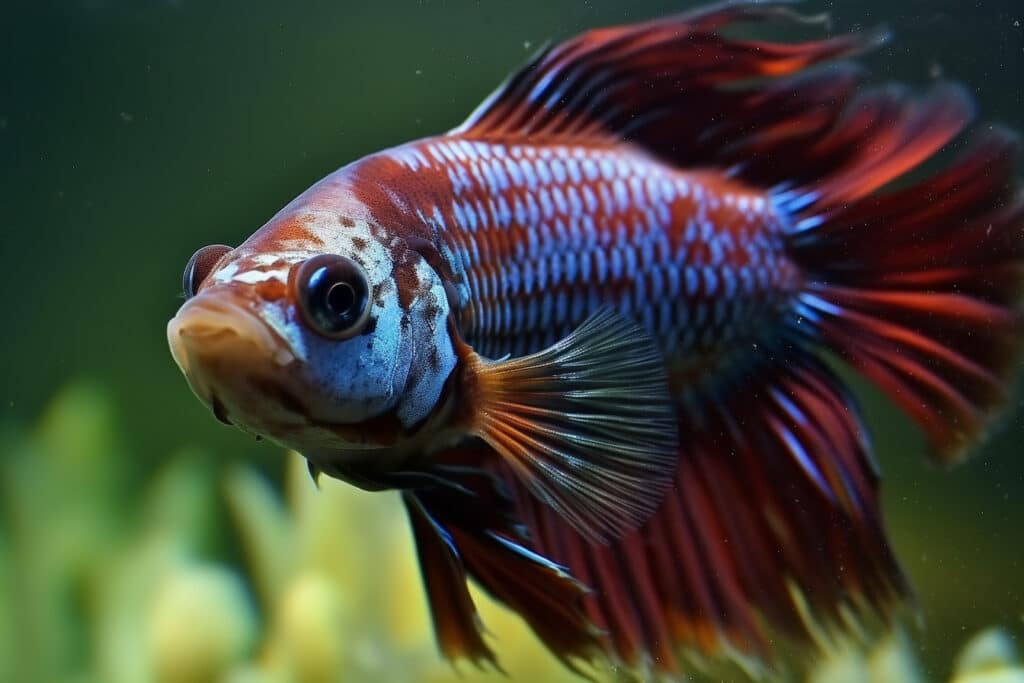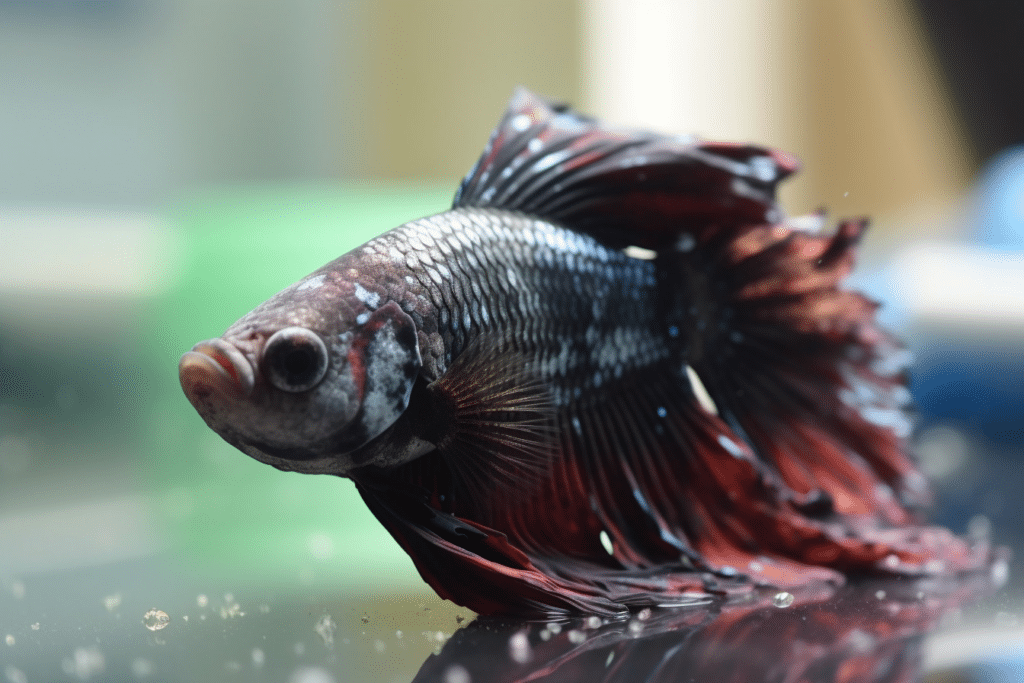Betta Fish Dropsy Best Cure and Prevention Tips!
Betta Fish Dropsy, Recognize the symptoms, understand the causes, and discover effective treatments for this serious condition.
Learn how to treat and prevent dropsy in betta fish with our comprehensive guide, ensuring the health and longevity of your Siamese friend

Table of Contents 🦑
Betta Fish dropsy is a distressing condition that can affect our finned friends, and knowing how to identify, treat, and prevent it is crucial for their well-being.
Medical Disclaimer: The information provided in this article is for educational purposes only and is not intended to replace professional veterinary advice. Always consult with a qualified veterinarian for any health concerns or treatments related to your pet. Your veterinarian can provide diagnoses and appropriate treatment options tailored to your pet’s specific needs.
What Is Betta Fish Dropsy?
Dropsy, also known as “Betta Bloat,” is a prevalent and concerning health condition that can affect Betta fish. It is not a disease in itself but rather a symptom of an underlying health problem.
Dropsy is characterized by the swelling of a Betta fish’s body, leading to a bloated appearance. This condition is often caused by the accumulation of fluids in the fish’s abdomen (belly) and can be visually identified by the pinecone-like protrusion of its scales.
While Dropsy can be alarming for Betta owners, understanding its causes and recognizing early signs is crucial for prompt intervention and the well-being of these beloved aquatic pets.
Identifying Physical Signs of Dropsy in Betta Fish
Identifying physical signs of Dropsy in Betta is crucial for early intervention and effective treatment. Careful observation of your Betta fish’s appearance can help you recognize these signs and take immediate action to address the issue.
5 Early Symptoms of Dropsy in Betta Fish
Identifying early symptoms of Dropsy is crucial in providing timely care and treatment for your Betta, It can help prevent the condition from progressing to a more severe stage and improve the chances of successful treatment.
Slight Bloating: In the early stages of Dropsy, you may notice a mild swelling or bloating in the Betta fish’s abdomen. It may not be as pronounced as in advanced cases, but it’s important to be vigilant for any changes in the fish’s appearance.
Behavior Changes: Betta with early Dropsy may exhibit subtle changes in behavior. They might become slightly less active, show reduced interest in food, or spend more time resting at the bottom of the tank or near the water’s surface.
Fins Clamping: The Betta fish’s fins might appear slightly clamped or held closer to the body than usual, which can indicate discomfort or stress.
Dull Coloration: You may notice a slight loss of color vibrancy in the Betta fish’s scales, making its appearance less vibrant than usual.
Slight Scales Raised: While the scales might not be fully pinecone-like, you might observe a subtle elevation of scales on the Betta fish’s body, particularly around the abdomen area.
Catch dropsy early, if you observe any of these early symptoms in your Betta, it’s essential to monitor its health closely and take action promptly.
Early detection and timely intervention can improve the chances of successful treatment and recovery. Seeking advice from a knowledgeable fish veterinarian is recommended to ensure proper care and treatment for your beloved Betta.
8 Advanced Symptoms of Dropsy in Betta Fish:
When Dropsy reaches an advanced stage, the symptoms become more pronounced and alarming. Advanced Dropsy requires immediate attention and professional care to give the Betta the best chance of recovery.
Severe Bloating: In advanced cases of Dropsy, the Betta fish’s abdomen becomes severely swollen and distended, resembling a pinecone-like appearance. This is a clear indication of fluid retention and a significant health concern.
Raised Scales: The scales on the Betta fish’s body become highly raised, giving it a pinecone-like appearance. This is a crucial sign of severe fluid accumulation within the body cavity.
Protruding Eyes: As the fluid builds up in the Betta fish’s body, it can also affect the eyes, causing them to protrude or become enlarged.
Lethargy and Weakness: The Betta may become extremely lethargic and weak, spending most of its time at the bottom of the tank or struggling to swim.
Loss of Appetite: Advanced Dropsy often leads to a complete loss of appetite in Betta, making it difficult for them to eat or show interest in food.
Difficulty Swimming: As the condition progresses, the Betta may struggle to maintain balance and have difficulty swimming properly due to increased fluid retention.
Respiratory Distress: The fish may show signs of respiratory distress, such as gasping for air at the water’s surface, as the fluid accumulation affects its ability to breathe.
Behavioral Changes: The Betta may become more reclusive and less responsive to its surroundings, indicating discomfort and pain.
It’s crucial to note that advanced Dropsy is a severe and life-threatening condition. If you observe any of these advanced symptoms in your Betta, it requires immediate attention and intervention. Seeking professional veterinary care is essential to provide the best possible chance for the fish’s recovery.
The Causes of Dropsy In Betta Fish
Dropsy in fish is a condition that can be caused by a variety of factors, It is primarily linked to internal bacterial infections.
The infection affects the fish’s kidney and other internal organs, leading to a disruption in their ability to regulate fluids and electrolytes. As a result, fluid accumulates in the fish’s body, causing the characteristic bloating and swelling associated with Dropsy.
These bacterial infections can be caused by poor water quality, stress, or exposure to contaminated environments. Additionally, Dropsy can be a symptom of an underlying health issue, such as organ failure or parasites.
Here is a list of 6 possible factors that can cause Dropsy in Betta fish:
Bacterial Infections: Internal bacterial infections, often caused by poor water quality, can lead to Dropsy in fish.
Stress: Stressful conditions, such as overcrowded tanks, sudden changes in water parameters, or aggressive tank mates, can compromised immune system of bettas and make them more susceptible to Dropsy.
Contaminated Water: Exposure to contaminated water or unclean tank conditions can introduce harmful bacteria and parasites, leading to Dropsy.
Poor Diet: Inadequate or improper nutrition can weaken the fish’s overall health and make them more prone to infections and illnesses like Dropsy.
Underlying Health Issues: Dropsy can sometimes be a symptom of an underlying health problem, such as organ failure or parasitic infestations.
Genetics: Some Bettas may have a genetic predisposition to develop Dropsy.
Understanding these potential causes can help fish enthusiasts take preventive measures and provide appropriate care to keep their Betta healthy and thriving.

Is Dropsy Contagious?
Dropsy itself is not contagious to other fish and tank mates. Dropsy is a symptom of an internal condition, usually caused by bacterial infections or organ failure. These underlying health issues may not necessarily be contagious, but they can be triggered by poor water conditions, stress, or other environmental factors that can affect multiple fish in the same aquarium.
However, if the root cause of Dropsy is a bacterial infection, the bacteria itself could be contagious to other fish in the tank. Bacterial infections can spread through the water, so it’s essential to quarantine any fish showing signs of illness to prevent the potential spread of infection to other tank mates.
To minimize the risk of illness and promote the overall well-being of all fish in the aquarium, maintaining good water quality, providing a stress-free environment, and quarantining sick fish when necessary are crucial steps to take. Regular observation and prompt action if any fish show signs of illness can help prevent the spread of disease and ensure the health of your fish community.
Steps to Take for a Healthy Aquarium
Betta fish Dropsy, Photo By BettaReef.com
If your betta has Dropsy and lives with other tank mates, it’s essential to act promptly to prevent the potential spread of the disease and ensure the well-being of all the fish in the tank. Here’s what you should do:
Isolate the Infected Betta: The first step is to separate the betta with Dropsy from the other tank mates. Transfer the sick betta to a quarantine tank or hospital tank immediately. A quarantine tank allows you to closely monitor and treat the betta fish without exposing other fish to the disease.
Observe Other Tank Mates: Keep a close eye on the remaining tank mates for any signs of illness or abnormal behavior. Quarantine any fish showing symptoms of illness in a separate tank as well.
Treat the Infected Betta: Once in the quarantine tank, start treatment for Dropsy. There are various treatment options available, including medications specifically formulated for treating Dropsy. Follow the instructions on the medication package carefully and continue treatment as recommended.
Monitor Water Quality: Ensure that the water quality in both the main tank and the quarantine tank is excellent. Perform regular water tests and water changes to keep ammonia, nitrite, and nitrate levels in check.
Disinfect Tank Equipment: If you suspect that the disease may have spread through tank equipment, thoroughly clean and disinfect all decorations, filters, and other accessories before returning them to the main tank.
Provide Supportive Care: During treatment, provide the infected betta with a stress-free environment, warm water, and high-quality food. A calm and healthy environment can aid in the recovery process.
Seek Veterinary Assistance: If the condition of the betta does not improve or worsen despite treatment, consult a veterinarian experienced in fish health. A professional diagnosis and advice can be valuable in identifying the root cause of the illness and providing appropriate treatment.
Continue Observation: Even after treatment and recovery, continue to observe the betta and other tank mates for any signs of illness. Be vigilant in maintaining optimal water conditions and addressing any issues promptly.
Remember that Dropsy can be caused by various underlying factors, such as poor water quality, stress, or infections. By taking swift and appropriate action, you can help your betta recover and prevent the spread of the disease to other tank mates. Regular monitoring, proper quarantine procedures, and attentive care are crucial in maintaining the health of your betta and the entire aquarium community.
Can You Cure Dropsy?
Curing Dropsy in betta fish can be very challenging, especially in the advanced stages of the disease, However, if caught early and if the underlying cause is bacterial, there may be a chance of successful treatment.
How to Treat Dropsy in Betta Fish
The first step in attempting to cure Dropsy is to identify and address any potential water quality issues or stressors in the aquarium. Regular water changes and maintaining good water conditions can help improve the overall health of the fish and support their immune system.
It is essential to consult with a qualified veterinarian or aquatic expert to determine the appropriate course of action and medication. Over-the-counter antibiotics may not always be effective or safe, so professional advice is crucial.
When it comes to treating betta Dropsy, there are several products available in the market that can aid in the recovery process. These products are designed to address the underlying causes of Dropsy and help alleviate the symptoms.
However, it’s essential to remember that Dropsy is often a symptom of an internal issue, and while these products may offer some relief, they may not always lead to a complete cure.
Some common betta fish Dropsy treatment products include:
Antibiotics: Certain antibiotics are designed to treat gram negative bacteria infections, which can be one of the contributing factors to Dropsy. These medications aim to combat bacterial infection and reduce the swelling associated with the disease.
Epsom Salt: Epsom salt baths are sometimes recommended to help draw out excess fluid from the betta’s body, which can reduce swelling and discomfort. However, it is crucial to use the correct dosage and duration, as excessive salt can be harmful to the fish.
Medicated Food: Medicated fish food may contain antibiotics or other medications to treat bacterial infections from within the betta’s digestive system.
Aquarium Salt: Aquarium fish salt can be used to create a slightly saline environment in the betta’s tank, which may help improve the fish’s overall health and alleviate some symptoms.
It’s important to note that while these products can be beneficial, they should be used under the guidance of a qualified veterinarian or fish expert.
In many cases, despite the best efforts, Dropsy may progress, and affected fish may not survive. Therefore, early detection and addressing any potential health issues promptly is crucial. Prevention through proper care, nutrition, and regular observation are the best approaches to ensure the well-being of your betta and reduce the risk of diseases like Dropsy.
The Time It Takes To Recover from Dropsy
The recovery time for a betta with Dropsy can vary significantly depending on several factors, such as the severity of the disease, the underlying cause, and the effectiveness of the treatment. In some cases, with early detection and appropriate treatment, betta may show signs of improvement within a few days to a week.
However, it is important to note that Dropsy is often a symptom of an internal issue, and not all cases may be treatable. In advanced stages or if the underlying cause is not bacterial, recovery may be more challenging, and the chances of full recovery may be lower.
Even with the best care and treatment, some betta may not fully recover from Dropsy, and the disease can be fatal. It is crucial to monitor the fish closely during the recovery process and be prepared for the possibility that not all cases will have a positive outcome.
If you notice signs of Dropsy in your betta, it is essential to take prompt action and seek advice from a qualified veterinarian or aquatic expert. Early intervention and proper care can improve the chances of a successful recovery and support the overall health of your beloved betta fish.
How to Prevent Betta Dropsy
Preventing Dropsy in betta fish is crucial to ensure the well-being and health of these beautiful aquatic pets. While Dropsy can sometimes occur despite our best efforts, there are several steps you can take to minimize the risk and promote a healthy environment for your betta.
Here are some essential tips to help prevent Dropsy in your betta fish:
Maintain Excellent Water Quality
Betta fish are sensitive to poor water conditions, and water quality is one of the most critical factors in their overall health. Regularly test the water parameters using a reliable test kit, and perform water changes accordingly to keep ammonia, nitrite, and nitrate levels in check. Aim for a pH level of around 6.5 to 7.5, which is within the optimal range for betta fish.
Provide a Proper Diet
A balanced and nutritious diet is essential for betta fish health. Feed them high-quality betta fish pellets that provide all the necessary nutrients. Additionally, supplement their diet with frozen or live food such as bloodworms, brine shrimp, and daphnia. Overfeeding can lead to digestive issues and poor water quality, so feed your betta fish small portions 2-3 times a day.
Quarantine New Fish
Before adding any new fish to your main tank, quarantine them in a separate tank for at least two weeks. This allows you to observe their behavior and check for signs of illness. If any issues arise during the quarantine period, you can treat them without affecting your main tank’s inhabitants.
Avoid Overcrowding
Overcrowding can lead to territorial disputes and stress in betta fish. Provide adequate space and hiding spots for each fish to reduce aggression. A general guideline is to have a minimum of 5 gallons of water per betta fish.
Monitor and Address Behavioral Changes
Get familiar with your betta’s typical behavior so that you can quickly identify any changes. Look for signs of lethargy, loss of appetite, clamped fins, or unusual color changes. If you notice any abnormalities, investigate and address the underlying cause promptly.
Avoid Sudden Water Changes
Sudden changes in water temperature or chemistry can stress betta fish and weaken their immune system. Gradually acclimate your betta fish to any new water conditions to minimize stress and ensure a smooth transition.
Quarantine and Isolate Sick Fish
If you notice any signs of illness, such as bloating, lesions, or abnormal behavior, quarantine the affected fish immediately. This prevents potential infections from spreading to other tank mates and allows you to provide targeted treatment.
Regular Fish Tank Maintenance
Regularly clean the tank and remove any uneaten food, waste, and debris. Perform partial water changes of about 20-30% every week to maintain optimal water quality.
By following these preventive measures and maintaining a proactive approach to your betta fish’s care, you can create a thriving and healthy environment that minimizes the risk of diseases like Dropsy. Remember to observe your betta fish regularly, provide proper nutrition, and respond promptly to any signs of distress or illness to ensure their well-being and longevity.
In conclusion
Dropsy is a serious health condition that can affect Betta fish, causing discomfort and distress. Identifying the symptoms early and taking prompt action is crucial for the well-being of your beloved aquatic companions.
By maintaining optimal water conditions, providing a balanced diet, and addressing any signs of illness immediately, you can reduce the risk of Dropsy, and keep a happy and healthy fish.
Remember, prevention is always better than cure, so stay vigilant and attentive to your Betta’s needs.
We hope this guide has been informative and helpful in your journey of caring for these enchanting fish. If you have any questions or experiences to share, please feel free to leave a comment below. Thank you for being part of our community of fish enthusiasts at Bettareef.com!

Delighted to have you here at BettaReef! This place is a treasure trove of knowledge about Betta fish, Betta Care, Health, Gear, and much more from the wonders of aquatic life. My journey in this fascinating world began when I was just 8, and now, as a seasoned hobbyist, I’m here to help fellow Betta enthusiasts create a thriving Betta environment for a healthy life.
I’m committed to delivering high-quality content, backed by a stringent editorial process. Each product review is based on real-life usage and practical analysis, ensuring that you get insights and advice that truly matter.
Related Blog Posts:

Betta Fish Bloat
Betta Fish Bloat Causes, Treatment, and Prevention Tips Explore effective treatments and prevention strategies for

Betta Fish Behavior Before Death
Betta Fish Behavior Before Death, Betta Fish Behavior Before Death: recognizing end-of-life signs, learn the

Betta Fin Rot: Symptoms, Causes, Prevention & Treatment
Swim To 🤿 Home Betta Fin Rot: Expert Strategies for Effective Treatment and Prevention While
